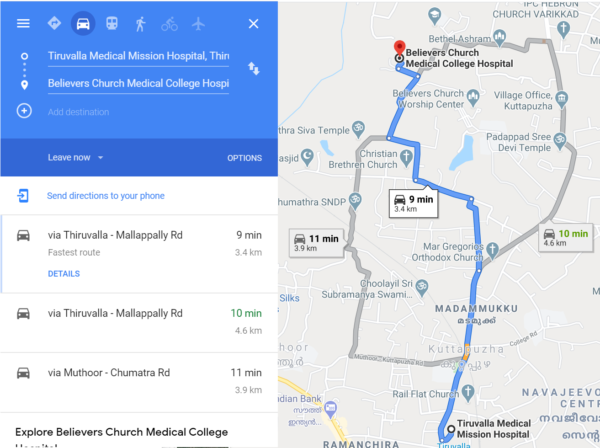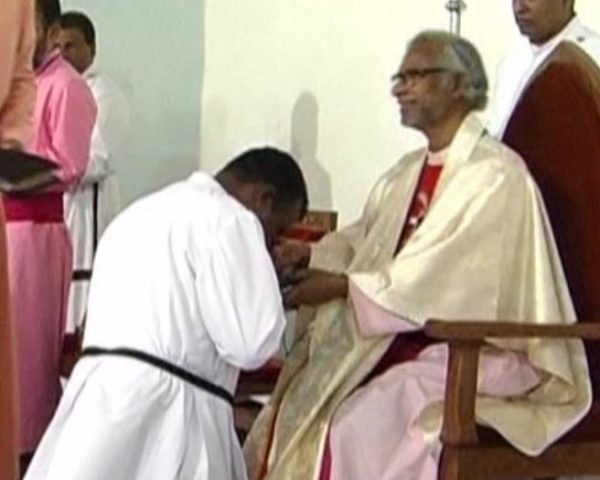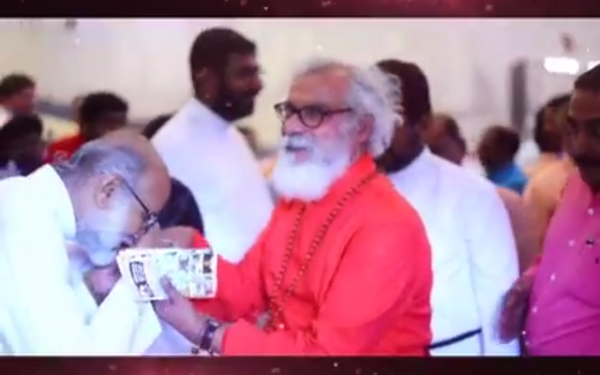In his interview with CBC reporter Angela MacIvor, Gospel for Asia spokesman Johnnie Moore justified the diversion of funds to Believers’ Church Medical College Hospital by saying there are no other hospitals in the area for “many miles.” This and nearly everything else Moore said in his interview requires scrutiny. I started that activity last week and this week, I turn my attention to the rest of the interview.
In this interview, MacIvor asked Moore why some of the funds donors gave for poor people went to build a state of the art hospital in Kerala (first reported here). In response, Moore said:
It was all happening. It was all happening. They were building hospitals, the hospital that you are referencing, I’ve been to it. I’ve walked around it. I’ve sat down with people being cared for in the hospital. I’ve sat with the director of the hospital. I’ve seen the gigantic statue of Jesus in the center of the hospital, and by the way, that hospital is the only hospital of its kind within a very long distance. I mean people come from all over that part of India to get great health care for themselves. Not only that, by the way, you know they’re training doctors and nurses to serve other people all across the country. You know, this is an organization that has always talked about providing healthcare and educating people and so they’re doing it, they’re doing it. And while they’re doing it, they’ve also provided goats and wells and medicine and literacy training.
There are problems here.
Moore said: “that hospital is the only hospital of its kind within a very long distance.”
Not true. There are at several other comparable hospitals within 30 miles of Believers’ Church Medical College Hospital. One, the Tiruvalla Medical Mission Hospital is a modern state of the art facility with a location only 3.4 km away (about a 9 minute drive) (see the image below).
 St. Ritas Hospital is 10 minutes away. St. Thomas Hospital is about 22 minutes away. Each has a nursing school and other medical training. There are numerous specialty clinics in the vicinity as well (heart, dental, etc.). Since Moore says he has been there, it seems like he should know that.
St. Ritas Hospital is 10 minutes away. St. Thomas Hospital is about 22 minutes away. Each has a nursing school and other medical training. There are numerous specialty clinics in the vicinity as well (heart, dental, etc.). Since Moore says he has been there, it seems like he should know that.
Moore added: “Not only that, by the way, you know they’re training doctors and nurses to serve other people all across the country.”
I am sure that the school does train doctors and nurses but Moore makes it seem as though there is a shortage of medical training in India. That is not true. According to this list, there are three other medical colleges in the same district (Pathanamthitta) of the state of Kerala as Yohannan’s. About 1.2-million people live in the district which covers just over 9 square miles. In the state of Kerala (the size of New Hampshire and Connecticut combined), there are 36 medical colleges with 2 more planned.
Moore: “I mean people come from all over that part of India to get great health care for themselves.”
While that may be true, they have to pay for it. Moore said there isn’t another hospital of its kind in the area, but the Believers’ Church hospital found one about 30 minutes away to send a poor patient to according to the Deccan Chronicle report.
A patient suffering from breathing difficulty, who was shifted from a private hospital at Thiruvalla to the MCH [Government Medical College Hospital] here on Wednesday, had to wait in the ambulance for over four hours due to the lack of a spare ventilator in the MCH. The doctors at the private hospital had told the relatives of the patient that medical colleges will have ventilator facility all the time. The plight suffered by the patient, N.K. Saaidharan Pillai, 58, of Pandalam, was explained to DC by his daughter Salini on Friday.
Pillai, who had breathing difficulty due to a neurological deficit, was undergoing treatment at the Believers Church hospital at Thiruvalla. However, he was shifted to the Kottayam medical college hospital on Wednesday as the family could not afford the huge expenses. Salini said that the doctor who administered treatment to her father at the Thiruvalla hospital told her that the MCH will have a full- time ventilator facility. “He told us that there was no need to ring up the MCH about arranging a ventilator,” she said.
This man couldn’t afford the care at Believers’ Church. Despite the millions given by donors to help poor people in India, this man could not get medical care at a facility that those foreign donations helped build. Does this look like the picture Johnnie Moore was painting?
The Deccan Chronicle report gives a hint that this patient wasn’t the only one dumped on the government hospital. The article concludes:
Meanwhile Winnie Elizabeth Johnson, PRO of the Believers Church hospital told DC that while the hospital authorities used to call them previously, since the MCH authorities used to come up with excuses against assurance regarding the ventilator facility citing increase in patient arrivals, they had stopped calling them anymore.
Apparently, Believers’ Church had been shipping so many patients to the MCH that MCH was coming up with reasons not to take them. Now Believers’ Church Hospital just dumps them. For some reason, she thought that was okay to admit.
Moore concluded: “this is an organization that has always talked about providing healthcare and educating people and so they’re doing it…”
This is a big part of the dispute between donors and GFA. In fact, GFA did not talk about building a hospital and that is the problem. Donors never heard about a hospital and when I first started covering GFA, it was scandalous that such a huge amount of money in fiscal year 2014 (over $14-million) of foreign donations went to the construction and maintenance of the hospital. There were no appeals for funds to build a hospital. It just appeared.
So no, GFA didn’t talk about building a hospital and ask for funds to do it. If Johnnie Moore can find an appeal and document a U.S. campaign in 2012-2014 to build the Believers’ Church Medical College Hospital, I would like to see it.
Apparently, former GFA COO David Carroll didn’t know about it either because he sent a nervous email to K.P. Yohannan after Bruce Morrison and I started asking questions about the Indian public documents (FC-6 Reports). Moore said in the interview that GFA contested the accuracy of those documents. However, David Carroll, GFA’s COO at the time, did not contest them. Here is what he said to K.P. Yohannan in early 2015 in an email reveal during the RICO court case:
Sir, I need to share with you where I am over this situation. I will try to summarize for brevity sake. We have a saying in our country: The numbers don’t lie. The published FC-6 reports show westerners that we have either sent money to the field raised for National Ministries and Bridge of Hope to fund the hospital and the corpus fund, or our FC-6 filings are filed wrong.
Either way, this is a huge problem. It appears to those reading these that we might have been dishonest to the donors (fraud), or been dishonest to the Indian government, (a PR nightmare at least). Sister Siny’s report below will, in my opinion, do little to satisfy those who are printing out and analyzing our FC-6 reports. I am sorry for not expressing more confidence than this. I think we may have used money raised for National Ministries and Bridge of Hope for the hospital.
I think that India feels that we raise money and send it. I think that India feels that we raised money and sent it to them and they can legally use it any way they deem fit. I hope that I am wrong, but I am doubtful. I also don’t think that it is an intentional wrong, but if I am correct, it is a huge wrong. We’ve spoken at hundreds of churches with tears asking for the National Ministries and Bridge of Hope support, and the FC-6 that is public says that we sent much of that money for the hospital and the reserve corpus funds.”
Yes, the money went “to the field” but David Carroll here in the privacy of this email is lamenting that Believers’ Church — which is run by K.P. Yohannan — spent funds meant for ministry to poor people on the hospital and to stock a reserve fund.
An Indian tax court document confirmed the transfer of funds in December 2014. According to the court filing:
…the assessee [Believers’ Church] advanced funds to BCMET [a trust to build the hospital] for construction of hospital building. BCMET is also a registered trust u/s 12AA of the Act. The ld.representative further submitted that Carmel Education Trust also a registered charitable trust u/s 12A of the Act was given funds by the assessee to carry out their charitable activities.
That same court opined that Believers’ Church and GFA used funds inappropriately:
It is not in dispute that substantial income of the assessee trust was not used by both the assessees for the purposes for which they were formed.
I don’t know if Angela MacIvor will get another chance to interview Mr. Moore. I hope so. I also hope U.S. media will follow up on the CBC documentary and bring more light to GFA.


